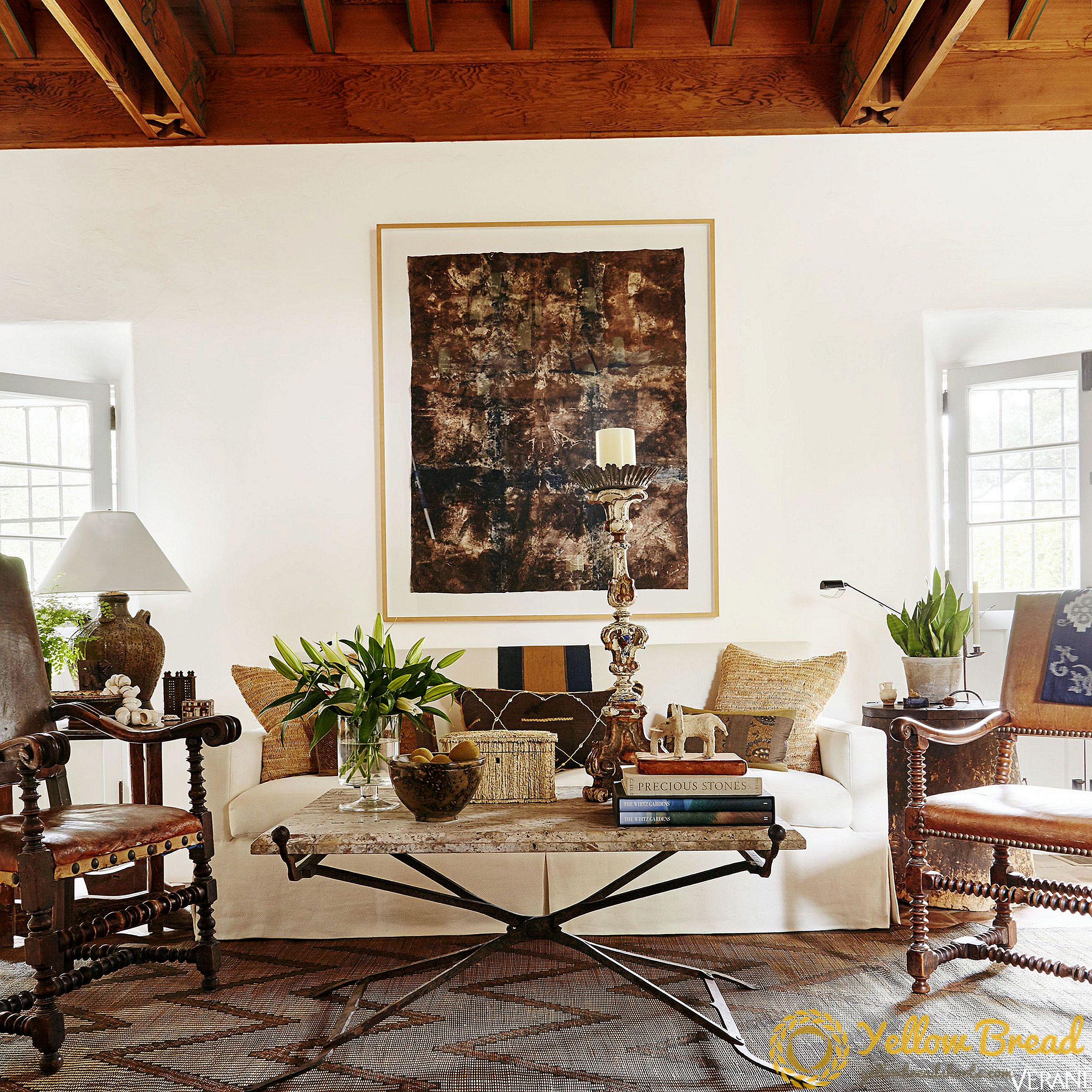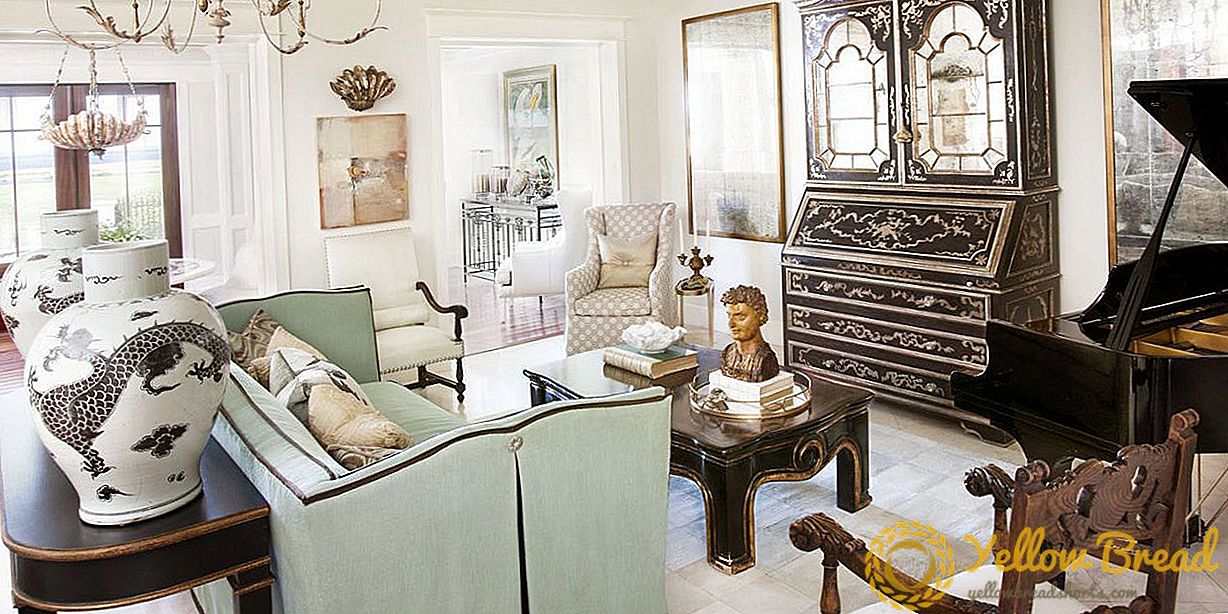Richard Hallberg can time-travel. The journey from Los Angeles, where the designer lives, to southern Spain's sun-swept Andalusia region takes the average person nearly two days, with multiple connections by plane, train, and automobile. Hallberg manages to do it in an hour and 20 minutes. He simply drives north to Montecito, passes through the hedge-decked gates of his estate, and then-poof! España. "When I get off the freeway," he says, "my shoulders drop."

For the coutryard steps, Hallberg imported antique French tiles in colors ranging from terra-cotta to blue-gray. Custom bench in a Formations fabric; coffee table, Dennis & Leen.
The California-born Hallberg has been fascinated by all things Andalusian since his first visit at age 15. "I always thought, How can I live in L.A. and Spain at the same time?" he says. His stateside design business-which includes reproduction-furniture companies Dennis & Leen and Formations-prevents a literal move.

An airy guest bedroom opens onto its own private courtyard. Bed, Formations; 18th-century English chair.
So this transportive three-bedroom getaway, just a seven-minute walk to the beach, is his antidote, with all the elements of a cinematic Spanish finca: 24-inch-thick walls, antique-stone floors, four fireplaces, multiple courtyards, and a tile roof. "If I'm here, I'm on vacation," he says. "It's like I've left the States."

In the great room, a substantial limestone mantel contrasts with the delicate metalwork of the Byzantine processional crown poised on top. 18th-century Spanish table; candlestick, Dennis & Leen.
In Los Angeles, Hallberg lives in a thoroughly modern space, the epitome of California cool. What he's created in Montecito is the opposite: a retreat that looks as if it's stood there, sun-kissed, for centuries, redolent of olive groves, with fountains gurgling and bunnies (bunnies!) puttering around the grounds. "I have the best of both worlds," he says. "The Gemini in me can have both."

An African mud cloth is framed as art. The lamp base is made from an antique French vessel; woven leather-and-reed Tuareg rug.
The house was built in 1926 by another American besotted with Spain. Noted Santa Barbara architect Lutah Maria Riggs designed it for herself, outfitting it with furniture and rugs she'd purchased on trips to Spain with her colleague, Spanish Revival architect George Washington Smith. Riggs owned the house for 60 years. "She called it Clavelitos, which means 'little carnations,'" Hallberg notes.

Pedestal sculpture, Dennis & Leen.
But by the time Hallberg bought it, after three years of searching for the perfect house, Clavelitos had fallen into a Grey Gardens-esque state of disrepair, with overgrown grounds that looked, as he puts it, like "a crazy tropical nightmare." Still, it had the right bones.

"I knew I could make that house feel European because of its scale-those thick walls, for example, and a 60-foot-long great room with 18-foot ceilings, plus fireplaces at either end." Hallberg redid the kitchen and baths in Spanish Revival style, importing more terra-cotta floor tiles, which he had tumbled, hand-patinated, and waxed so that they would appear aged.

Vintage French rattan chairs and painted African baskets in the dining room.
The rooms look as though they've been pulled together effortlessly. "This is not truly a design job," Hallberg says. "It's an assemblage of things that I've acquired over the decades, all meant to feel like they've been here for years." A 17th-century Italian plaque hangs in the great room. A collection of tiny whisk brooms dangles from a shelf in the dining room. And there's nary a lightbulb in sight-they're all hidden behind sleeves.

Outdoor cushion and pillow fabrics, Formations.
Outside, Hallberg made even more significant enhancements. Adjacent to the house, he installed a pool and terrace-complete with a rare 16th-century stone lion presiding over the grounds-where he hosts parties. The oaks were already there, but Hallberg planted mature olive trees, as well as sheltering Ficus nitida hedges that have grown to be 14 feet tall.

The original wood staircase with 14-inch-tall treads; table, Dennis & Leen.
He kept the garden purposefully green, selecting indigenous plantings that also flourish in Andalusia-but no colorful flowers. "The house was a jewel," Hallberg says, "and I wanted to wrap it up in a green box."
PIONEER WOMAN
The groundbreaking architect Lutah Maria Riggs crafted an extraordinary vision, especially at her own home, Clavelitos, now owned by Richard Hallberg.

At a time when most women were working in the home, Lutah Maria Riggs was working on homes. The architect, born in 1896, was nothing if not a trailblazer: She was awarded a scholarship meant for men, which she used at UC Berkeley, and later talked her way into a draftsman's job with noted architect George Washington Smith. Riggs was an architect for 60 years and the first female Californian to be named a Fellow of the American Institute of Architects.

Her hallmark: Spanish Revival homes tailored specifically for their owners. "Lutah was a bit of a loner," says Gretchen Lieff, founder of the Lutah Maria Riggs Society. "Yet she produced some of the most enlightened, comfortable architecture in the community." lutah.org.






